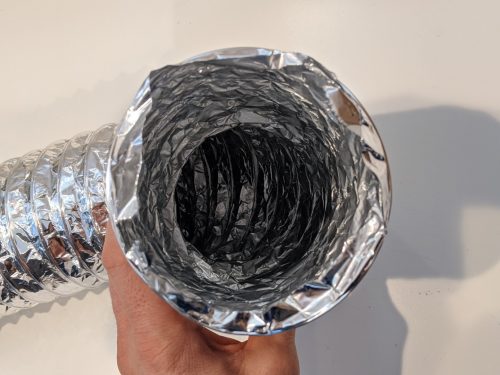Foil dryer transition ducts are allowed by code and by some clothes dryer manufacturers. This seems to be a frequent topic of discussion and confusion amongst home inspectors, so I’m going to shed some light on the topic. First, let’s define what a dryer transition duct is.
A dryer transition duct is a flexible section of duct that can be used to connect a clothes dryer to the duct. The duct itself must consist of rigid metal.
What the code says about foil dryer ducts
The building code is actually silent on the type of material that may be used for a dryer transition duct. The code simply says that dryer transition ducts must be UL 2158A listed. They leave it up to UL to figure out what passes muster and what doesn’t.
The building code also requires clothes dryers to be installed according to the manufacturer’s installation instructions, in accordance with section 304.1 of the Minnesota Mechanical Code. This section corresponds to section M1307.1 in the 2018 IRC for people in other parts of the country.
If you stop by any home improvement store, you’ll find that the products sold as dryer transitions ducts are mostly UL 2158A listed. Not all of them, but most of them. I have a bunch of comparison photos in my blog post on dryer duct safety.
What manufacturers say about foil dryer ducts
Clothes dryer manufacturers are surprisingly inconsistent with their requirements for dryer transition ducts. The following manufacturers do not allow dryer transition ducts that are made from foil, regardless of whether the duct is UL2158A or not:
- Whirlpool
- Electrolux
- Amana
- Maytag
Kenmore and LG aren’t clear. In the same manual, they gave conflicting advice. Kenmore said If a flexible metal (foil type) duct is installed, it must be of a specific type identified by the appliance manufacturer as suitable for use with clothes dryers. So they’re allowed, right? Not so fast. They also go on to say Check your vent to make sure it is rigid or semi-rigid metal ducting. If your venting is plastic or flexible foil, have it replaced before using the dryer.
LG says To reduce the risk of fire, DO NOT exhaust the dryer with plastic or thin foil ducting, but then goes on to say In the United States, only those foil-type flexible ducts, if any, specifically identified for use with the appliance by the manufacturer and that comply with the Outline for Clothes Dryer Transition Duct, Subject 2158A, shall be used. So maybe it’s cool. I’m not sure.
Similar advice is given by Samsung, Hotpoint, and GE. The crazy thing about GE, however, is how specific they get with their advice. They say the following: In special installations, it may be necessary to connect the dryer to the home exhaust vent using flexible metal (foil-type) transition duct. UL–LISTED universal flexible dryer transition duct (GE parts – PM8X73 or WX8X73) may be used ONLY in installations where rigid metal or flexible metal transition ducting cannot be used AND where a 4” diameter can be maintained throughout the entire length of the transition duct.
What’s even crazier about GE is that they re-sell DryerFlex under the GE name (https://dryerflex.com/), but they don’t list it as an acceptable material in their installation manuals! Let me repeat: they put their name on this superior product, but they don’t allow it on their own dryers. I think my head is going to explode.
Hey dryer manufacturers, can you please all get on the same page? One standard would really be nice. Thank you.
So what now?
The bottom line is that foil dryer ducts are allowed by code and some manufacturers. That doesn’t mean they’re a great product, however. To demonstrate this, I partnered up with the fine folks at Family Handyman to do a video. I’ll share that in next week’s blog post.




Yury Slutsky
December 3, 2019, 8:52 am
Hello Ruben,
I don’t know if this paragraph was changed but, here is what I found:
504.6 Domestic clothes dryer ducts. Exhaust ducts for domestic clothes dryers shall be constructed of metal and shall have a smooth interior finish.
Reuben Saltzman
December 3, 2019, 2:30 pm
Hi Yury,
That’s correct, but that refers to the duct. I’m referring to the transition duct. See section 504.6.3 Transition ducts. Transition ducts used to connect the dryer to the exhaust duct system shall be a single length that is listed and labeled in accordance with UL 2158A. Transition ducts shall be a maximum of 8 feet (2438 mm) in length and shall not be concealed within construction.
Michael Leavitt
December 3, 2019, 12:15 pm
Reuben, once again you have provided solid gold advice. Don’t think you are alone, my head is still spinning a bit from the mixed advice from manufacturers written purely to limit their liability when the 4-year-old, never been cleaned out flexible duct traps enough lint to start the fire that burns down the house and possible kills the residents. Keep up the great research! Michael Leavitt – http://www.TheHomeInspector.com – Orem, Utah
Reuben Saltzman
December 3, 2019, 2:30 pm
Thanks, Michael!
Ron Nelson
December 3, 2019, 4:45 pm
We purchased a Maytag dryer last year and THEY installed it. They put a FOIL duct to outside!
Reuben Saltzman
December 3, 2019, 6:23 pm
That’s crazy!
Harry Janssen
December 3, 2019, 7:22 pm
Reuben, it sure is very confusing, if it appears to be an issue report it
Good article
Harry
Liz Sands
December 3, 2019, 8:29 pm
It may be allowed in code, but when I had a gas dryer installed and the tech used a foil dryer duct, the St. Paul city inspector failed it. I had to have the installer come back and put in a metal duct.
Reuben Saltzman
December 4, 2019, 5:15 am
Very interesting. I wonder what rules that inspector was going by?
Yury Slutsky
December 4, 2019, 10:34 am
How about something like that?
https://media.giphy.com/media/Kl1wRYe6PTQZO/giphy.gif
Reuben Saltzman
December 4, 2019, 2:40 pm
I think it looks awesome. I’ll have to ask them to send me one to test.